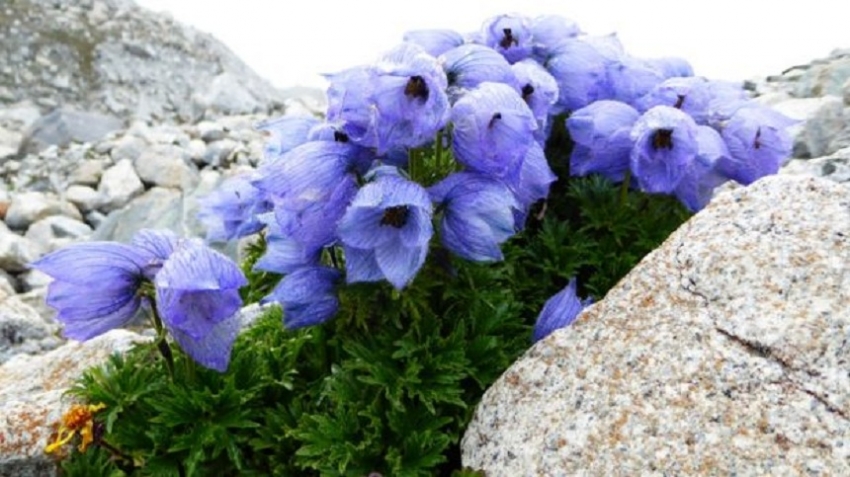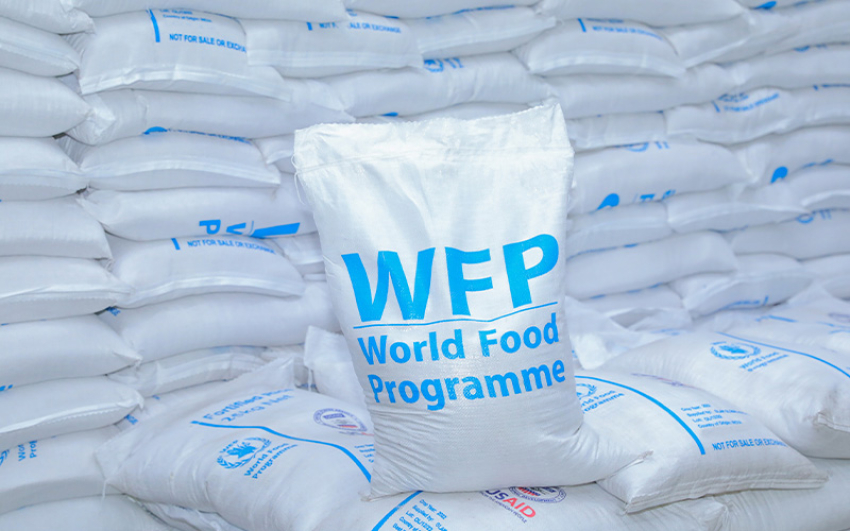Vegetation is expanding at high altitudes in the Himalayas, including in the Everest region, new research has shown.The researchers found plant life in areas where vegetation was not previously known to grow.A team used satellite data from 1993 to 2018 to measure the extent of plant cover between the tree-line and the snow-line.The results are published in the journal Global Change Biology.The study focused on the subnival region - the area between the tree-line (the edge of the habitat at which trees are capable of growing) and the snow line (the boundary between snow-covered land and snow-free land).Subnival plants are mainly small grasses and shrubs.
"The strongest trend in increased vegetation cover was between 5,000 metres and 5,500 metres altitude," said Dr Karen Anderson, from Exeter University, lead author of the report."At higher elevations, the expansion was strong on flatter areas while at lower levels that has been observed on steeper slopes."Using Nasa's Landsat satellite images, the researchers divided the heights into four "brackets" between 4,150m and 6,000m.It covered different locations in the Hindu Kush Himalayas, ranging from Myanmar in the east to Afghanistan in the west.
Earlier research had shown expansion of the tree-line at lower elevationsIn the Everest region, the study found a significant increase in vegetation in all height brackets.Other researchers and scientists working on glaciers and water systems in the Himalayas have confirmed the expansion of vegetation."It (the research) matches the expectations of what would happen in a warmer and wetter climate," said Prof Walter Immerzeel, with the faculty of geosciences at Utrecht University in the Netherlands, who was not involved in the study."This is a very sensitive altitudinal belt where the snowline is. A withdrawal of the snowline to higher altitudes in this zone provides opportunity for vegetation to grow."
The extent of vegetation in 1993 (blue) vs 2017 (red), derived from Landsat data in the region around Mount EverestThe research did not examine the causes of the change.Other research has suggested Himalayan ecosystems are highly vulnerable to climate-induced vegetation shifts."We have found the tree-line expanding in the subalpine regions of Nepal and China as the temperature rises," said Achyut Tiwari, assistant professor with the department of botany at Nepal's Tribhuvan University."If that is happening with trees at lower elevations, clearly the plants at higher altitudes will also be reacting to the rise in temperature."Some scientists regularly visiting the Himalayas have confirmed this picture of expanding vegetation."Plants are indeed colonising the areas that once were glaciated in some of these Himalayas," said Elizabeth Byers, a vegetation ecologist who has carried out field studies in the Nepalese Himalayas for nearly 40 years."At some locations where there were clean-ice glaciers many years ago, now there are debris-covered boulders, and on them you see mosses, lichens, and even flowers."
Some locations high up in the Himalayas have flowering plants like theseLittle is known about plants at these even-higher altitudes, as most scientific studies have focused on retreating glaciers and expanding glacial lakes amid rising temperatures.The researchers said detailed field studies on vegetation in the high Himalayas were required to understand how the plants interact with soils and snow."What does the change in vegetation mean for the hydrology (the properties of water) in the region is one of the key questions," said Dr Anderson."Will that slow down the melting of glaciers and ice sheets or will it accelerate the process?"The Hindu Kush Himalayan region extends across all or part of eight countries, from Afghanistan in the west to Myanmar in the east. More than 1.4 billion people depend on water from this region.
1.9 billion people rely on natural 'water towers'
By Jonathan Amos
Women tend their potato crop in Chipursan valley, Pakistan. The region is part of the Indus water tower
In a unique study, scientists have assessed and ranked the importance of Earth's great "water towers".
These are the 78 mountainous regions that are able to generate and then store vast quantities of water.
They deliver it in a controlled way to major populations living downstream.
The Dutch-led team finds Asia's Indus basin - fed by the Himalayan, Karakoram, Hindu-Kush, and Ladakh ranges - to be the most important storage unit on the planet.
Its waters, produced at high elevation from rain and snow, and draining from lakes and glaciers, support more than 200 million people settled across parts of Afghanistan, China, India and Pakistan.
But the Indus water tower, the researchers point out, is also the most vulnerable on their list of 78.
It's subject to a range of current and future pressures, from ever greater demand - for more drinking water, for increased irrigation and industry, etc - to issues that could severely curtail supply. The latter will include geopolitical tensions, given the Indus intersects national boundaries; but the most obvious threat is climate change. A warming world will disrupt precipitation patterns and denude glaciers of their storage capacity.
Asia's glaciers put the brakes on
Spy satellites reveal rapid Himalayan glacier melt
Media captionProf Walter Immerzeel: "Our data can underpin mountain-specific policies and water treaties"
"If, basically, the demand is higher but the supply decreases, then we really have a problem," said research team-member Dr Tobias Bolch from the University of St Andrews, UK.
"And this is, I think, one of the major strengths of our study - that we have looked closely at both sides, so the supply index and the demand index," he told BBC News.
Dr Bolch is speaking here at the American Geophysical Union's Fall Meeting, the largest annual gathering of Earth scientists. His and colleagues' work is being published simultaneously in the journal Nature.
Image copyrightMARK FISHER/NATIONAL GEOGRAPHIC
Image caption
Installing a new weather station on Everest: The study incorporates novel data-sets
The team conducted the assessment across the major continents, identifying what it regarded as the five most relied-upon, natural water tower systems in those regions:
Asia: Indus, Tarim, Amu Darya, Syr Darya, Ganges-Brahmaputra
Europe: Rhône, Po, Rhine, Black Sea North Coast, Caspian Sea Coast
North America: Fraser, Columbia and Northwest United States, Pacific and Arctic Coast, Saskatchewan-Nelson, North America-Colorado
South America: South Chile, South Argentina, Negro, La Puna region, North Chile
Africa does not appear in this listing, principally because it is devoid of major glacier systems. Ice bodies do exist on the continent, in places such as on Mount Kilimanjaro and Mount Kenya, but their contribution to downstream catchments is limited.
And one of the defining aspects of the towers is the way they are able to maintain essential water supplies to populations even in drought years through the steady melt of high-elevation ice in summer months.
What's clear from the study is just how much more vulnerable the Asian towers are compared with the rest of the world. Some of that has to do with projected future demand. Population growth in Asia will be much higher than in Europe, for instance.
But in Asia, too, there are specific political stresses that will challenge the future reliability of towers.
Image copyrightMATTHEW PALEY/NATIONAL GEOGRAPHIC
Image caption
The Shimshal Pamir region of Pakistan, Water from here flows through the Indus basin
Examples include the Amu Darya and Syr Darya river basins. Their waters - again sourced from high-mountain glaciers - run through low-precipitation areas where there is intense competition for irrigation for agriculture. The much reduced size of the Aral Sea, which both rivers ultimately feed, is evidence of this.
"What we recommend in our study is that we should really recognise mountains as global assets of the Earth system, and that means mountain ranges should be at the top of political agendas, and dedicated policies should be developed," co-team leader Prof Walter Immerzeel from Utrecht University said.
"We are only the scientists; we put out the numbers. But we've got very much better at that over the past two decades, so we can give really specific scientific background that can help for example to develop water treaties. We can aid the process."
Dr Bethan Davies, a team-member from Royal Holloway, University of London, commented: "I think when we've talked about climate change and ice loss, a lot of the narrative has been around sea-level rise. But actually over the next 100 years, climate change is going to affect drinking water for people, water for power, water for agriculture - and in these water towers, we're talking about the supply to about 1.9 billion people. That's more than 20% of the world's population.
"We need to adopt urgent mitigation strategies or we will face severe water shortages," she told BBC News.
The water towers study was supported by National Geographic and Rolex as part of their Perpetual Planet partnership. A portal allows users to explore the data and compare tower rankings.
Himalayan and other Asian glaciers put the brakes on
By Jonathan Amos
BBC Science Correspondent, Washington DC
10 December 2018
Share this with Facebook Share this with Messenger Share this with Twitter Share this with Email Share
Related TopicsAGU meeting
Media captionAmaury Dehecq: "Knowing ice-flow speed allows us to better estimate glacier melt"
The glaciers that flank the Himalayas and other high mountains in Asia are moving slower over time.
Scientists have analysed nearly 20 years of satellite images to come to this conclusion.
They show that the ice streams which have decelerated the most are the ones that have also thinned the most.
The research has implications for the 800 million people in the region for whom the predictable meltwater from these glaciers is a key resource.
The study is being presented at this week's American Geophysical Union (AGU) meeting in Washington DC - the world's largest annual gathering of Earth and space scientists.
How was the research done?
Led by the US space agency (Nasa), the assessment draws on one million pairs of pictures acquired by the Landsat-7 spacecraft between 2000 and 2017.
Automated software was used to track surface features on glaciers in 11 areas of High Mountain Asia, from Pamir and Hindu Kush in the West, to Nyainqêntanglha and inner Tibet and China in the East.
As the markers were observed to shift downslope, they revealed the changing speed of the ice streams.
The research team, headed by Dr Amaury Dehecq from Nasa's Jet Propulsion Laboratory, says nine of the surveyed regions show a sustained slowdown during the study period.
Nyainqêntanglha, for example, has seen a 37% reduction in speed per decade. For Spiti Lahaul, it is 34% - equivalent to about -5m/year per decade. These are glaciers that would normally move at tens of metres per year.
Image copyrightF.PAUL/NASA/USGS
Image caption
Landsat has built multi-decade records of glacier behaviour in Asia
What was the key finding?
Perhaps the major revelation is that the reduction in velocity is strongly correlated with thinning. Nyainqêntanglha's glaciers have been thinning on average by about 60cm a year; Spiti Lahaul's glaciers are losing thickness at a rate of roughly 40cm a year.
"The reason a glacier flows is because of gravity," explained Dr Dehecq. "Under its weight, the glacier slides across its bed and deforms, but as it thins it finds it more difficult to slide and deform; it's kind of intuitive.
"But until now there had been some debate as to whether other factors were influencing speed, such as the lubrication of the bed as a result of increased meltwater getting under the glacier. Well, we show thinning is actually the dominant factor," he told BBC News.
Are some glaciers getting faster?
The slowdown trend is strongest in the south and southeast of High Mountain Asia; it is less pronounced in the West.
Regions like the Karakorum in Pakistan, and Kunlun just across the border in Tibet/China, have actually shown a slight thickening over time and a marginal speed-up as a consequence.
"That's the influence of different climatic conditions," said co-author Dr Noel Gourmelen from Edinburgh University, UK. "Precipitation in the East is affected by the Asian monsoon and in the West and North-West, it is delivered by westerlies; although it's not exactly clear why the Karakorum has been gaining mass."
Image copyrightSHYLENDRAHOODE
Image caption
Galcier meltwaters ensure south Asia has a consistent supply of water, even in drought
Why is this research important?
The meltwater that flows from the 90,000 glaciers in High Mountain Asia is critical to the lives and livelihoods of the people downstream. But the significance goes much wider, because the snow and ice stored "in the freezer" at high altitude would otherwise push up global sea levels if it all melted and ran into the ocean. That is why scientists need to understand how the glaciers will respond in an ever-warming world.
This study, which has also been published in the journal Nature Geoscience, has described an important dynamic that will moderate how much ice is transported down mountains to the elevations where it can melt.
Computer models that try to project the future resilience of the glaciers in what they call Earth's "third pole" must now take account of this behaviour.
Dr Hamish Pritchard from the British Antarctic Survey also studies these glaciers. He said their contribution to rivers across the region was small in the average year, but significantly heightened during years of drought.
"My research shows that when the summer rains fail, glacier melt comes to dominate water inputs to many catchments in India, Nepal, Pakistan, Tajikistan and Kyrgyzstan. Without this water supply more crops would fail, substantially less hydropower would be generated and more people would be forced to migrate," he told BBC News.
"These rivers that flow down from the mountains pass through many communities and across national borders, so when supplies are low, tensions between neighbouring communities and countries would likely increase.
"Studies show that this tension could lead to conflict, with implications far beyond South and Central Asia.
"The key role of these glaciers then is as a buffer against the worst effects of drought, and so the loss of glacier ice can be seen as a threat to the future stability of the region."
Spy satellites reveal extent of Himalayan glacier loss
By Rebecca Morelle
Science Correspondent, BBC News
19 June 2019
Share this with Facebook Share this with Messenger Share this with Twitter Share this with Email Share
Related TopicsCold War
Image copyrightNRO/USGS
Image caption
The Hexagon images were declassified in 2011 and digitised for scientific study
Images from Cold War spy satellites have revealed the dramatic extent of ice loss in the Himalayan glaciers.
Scientists compared photographs taken by a US reconnaissance programme with recent spacecraft observations and found that melting in the region has doubled over the last 40 years.
The study shows that since 2000, glaciers heights have been shrinking by an average of 0.5m per year.
The researchers say that climate change is the main cause.
"From this study, we really see the clearest picture yet of how Himalayan glaciers have changed," Joshua Maurer, from Columbia University's Lamont-Doherty Earth Observatory in New York, told BBC News.
The research is published in the journal Science Advances.
Asia's glaciers put the brakes on
Warming threatens Himalayan glaciers
Melting glaciers reveal Everest bodies
Image copyrightNRO
Image caption
The Hexagon satellites were a top secret American reconnaissance programme
During the 1970s and 1980s, a US spy programme - codenamed Hexagon - launched 20 satellites into orbit to secretly photograph the Earth.
The covert images were taken on rolls of film that were then dropped by the satellites into the atmosphere to be collected mid-air by passing military planes.
The material was declassified in 2011, and has been digitised by the US Geological Survey for scientists to use.
Among the spy photos are the Himalayas - an area for which historical data is scarce.
By comparing these pictures with more recent satellite data from Nasa and the Japanese space agency (Jaxa), the researchers have been able to see how the region has changed.
The Columbia University team looked at 650 glaciers in the Himalayas spanning 2,000km.
The group found that between 1975 and 2000, an average of 4bn tonnes of ice was being lost each year.
But between 2000 and 2016, the glaciers melted approximately twice as fast - losing about 8bn tonnes of ice each year on average.
Image copyrightNASA
Image caption
We now have a satellite record approaching nearly 50 years in length
Mr Maurer said: "For a sense of scale, 8bn tonnes of ice is enough to fill 3.2 million Olympic-sized swimming pools per year."
And the ice loss was not uniform, he added.
"Glaciers lose most of their ice in the lower elevation portions of the glacier, and it's there where most of the thinning is concentrated.
"Some of those zones have been thinning by as much as 5m per year."
Among the scientific community, there has been some debate over the cause. Changes in rainfall in the region and soot deposited from industrial pollutants are thought to have hastened the melt.
However the Columbia team said that while these factors were contributing, rising temperatures in the Himalayas were the main cause.
"The fact we see such a similar spatial pattern of ice loss across so many glaciers across such a large and climatically complex region suggests there needs to be some kind of overall forcing affecting all of the glaciers similarly."
The Hexagon photographs would come down in a capsule from the satellites
Scientists say continued losses will have a huge impact.
In the short-term, the huge increase in meltwater could cause flooding.
In the longer term, millions of people in the region who depend on glacier meltwater during drought years could experience very real difficulties.
Commenting on the research, Dr Hamish Pritchard from the British Antarctic Survey, said: "What's new here is being able to see how the melting of glaciers across the whole Himalayan range has increased due to climate change.
"Over one generation, the melt has doubled and these glaciers are now shrinking fast.
"Why does this matter? Because when the ice runs out, some of Asia's most important rivers will lose a water supply that keeps them flowing through drought summers, just when water is at its most valuable.
"Without mountain glaciers, droughts will be worse for millions of water-stressed people living downstream."
Himalayan and other Asian glaciers put the brakes on
By Jonathan Amos
BBC Science Correspondent, Washington DC
10 December 2018
Share this with Facebook Share this with Messenger Share this with Twitter Share this with Email Share
Related TopicsAGU meeting
Media captionAmaury Dehecq: "Knowing ice-flow speed allows us to better estimate glacier melt"
The glaciers that flank the Himalayas and other high mountains in Asia are moving slower over time.
Scientists have analysed nearly 20 years of satellite images to come to this conclusion.
They show that the ice streams which have decelerated the most are the ones that have also thinned the most.
The research has implications for the 800 million people in the region for whom the predictable meltwater from these glaciers is a key resource.
The study is being presented at this week's American Geophysical Union (AGU) meeting in Washington DC - the world's largest annual gathering of Earth and space scientists.
How was the research done?
Led by the US space agency (Nasa), the assessment draws on one million pairs of pictures acquired by the Landsat-7 spacecraft between 2000 and 2017.
Automated software was used to track surface features on glaciers in 11 areas of High Mountain Asia, from Pamir and Hindu Kush in the West, to Nyainqêntanglha and inner Tibet and China in the East.
As the markers were observed to shift downslope, they revealed the changing speed of the ice streams.
The research team, headed by Dr Amaury Dehecq from Nasa's Jet Propulsion Laboratory, says nine of the surveyed regions show a sustained slowdown during the study period.
Nyainqêntanglha, for example, has seen a 37% reduction in speed per decade. For Spiti Lahaul, it is 34% - equivalent to about -5m/year per decade. These are glaciers that would normally move at tens of metres per year.
Image copyrightF.PAUL/NASA/USGS
Image caption
Landsat has built multi-decade records of glacier behaviour in Asia
What was the key finding?
Perhaps the major revelation is that the reduction in velocity is strongly correlated with thinning. Nyainqêntanglha's glaciers have been thinning on average by about 60cm a year; Spiti Lahaul's glaciers are losing thickness at a rate of roughly 40cm a year.
"The reason a glacier flows is because of gravity," explained Dr Dehecq. "Under its weight, the glacier slides across its bed and deforms, but as it thins it finds it more difficult to slide and deform; it's kind of intuitive.
"But until now there had been some debate as to whether other factors were influencing speed, such as the lubrication of the bed as a result of increased meltwater getting under the glacier. Well, we show thinning is actually the dominant factor," he told BBC News.
Are some glaciers getting faster?
The slowdown trend is strongest in the south and southeast of High Mountain Asia; it is less pronounced in the West.
Regions like the Karakorum in Pakistan, and Kunlun just across the border in Tibet/China, have actually shown a slight thickening over time and a marginal speed-up as a consequence.
"That's the influence of different climatic conditions," said co-author Dr Noel Gourmelen from Edinburgh University, UK. "Precipitation in the East is affected by the Asian monsoon and in the West and North-West, it is delivered by westerlies; although it's not exactly clear why the Karakorum has been gaining mass."
Warming threatens Himalayan glaciers
By Matt McGrath
Environment correspondent
4 February 2019
Share this with Facebook Share this with Messenger Share this with Twitter Share this with Email Share
Related TopicsClimate change
Image copyrightGETTY IMAGES
Climate change poses a growing threat to the glaciers found in the Hindu Kush and Himalayan mountain ranges, according to a new report.
The study found that if CO2 emissions are not cut rapidly, two thirds of these giant ice fields could disappear.
Even if the world limits the temperature rise to 1.5C this century, at least one third of the ice would go.
The glaciers are a critical water source for 250 million people living across eight different countries.
A Himalayan home for Buddhist nuns
East Antarctica's glaciers are stirring
Last four years are 'world's hottest'
The towering peaks of K2 and Mount Everest are part of the frozen Hindu Kush and Himalayan ranges that contain more ice that anywhere else on Earth, apart from the polar regions.
But these ice fields could turn to bare rocks in less than a century because of rising temperatures, say scientists.
Over the next few decades, the melting could accelerate thanks to warming and increased air pollution from a growing population.
The air pollutants come from the Indo-Gangetic Plain, one of the world's most polluted regions. The dirty air makes the glacier situation worse by depositing black carbon and dust on the ice, hastening the thaw.
Image copyrightGETTY IMAGES
Image caption
Climbers near Mount Everest
If global temperatures rise by 2 degrees C, then half the glaciers would be gone by 2100.
Even if the world takes dramatic action and limits warming to 1.5C by the end of the century, 36% of the glaciers will have disappeared.
"This is the climate crisis you haven't heard of," said Philippus Wester of the International Centre for Integrated Mountain Development (ICIMOD), who led the report.
"Impacts on people in the region, already one of the world's most fragile and hazard-prone mountain regions, will range from worsened air pollution to an increase in extreme weather events. But it's the projected reductions in pre-monsoon river flows and changes in the monsoon that will hit hardest, throwing urban water systems and food and energy production off kilter."
The area in question covers some 3,500km across Afghanistan, Bangladesh, Bhutan, China, India, Myanmar, Nepal and Pakistan.
The glaciers feed ten of the world's most important river systems, including the Ganges, Indus, Yellow, Mekong and Irrawaddy, and directly or indirectly supply billions of people with food, energy, clean air and incomes.
Image copyrightGETTY IMAGES
Image caption
A glacier melting into a lake in the Himalayas
The impacts that the scientists are worried about will hit not just those living in the mountains, but also the 1.65 billion people living in the river valleys below - all are vulnerable to flooding and the destruction of crops.
"Water is the theme that runs through many of the issues facing not just the mountain communities but the millions living downstream too. This report highlights how the retreat of snow and ice will change the way rivers behave, at first boosting their flow in spring and summer over the coming years, but only until the ice has melted away," said Dr Hamish Pritchard from the British Antarctic Survey.
"For me, the interesting question then is what happens in these major river basins in the years when the rains fail? Without the ice reserve there in the mountains to top the rivers up through the melt season, droughts will be harsher on those living downstream.
"This is a region where water is a hot topic politically, economically and in day to day life, and harsher droughts could be a severe shock to an already fragile system. I read this report as a warning to prepare for these shocks."
Galcier meltwaters ensure south Asia has a consistent supply of water, even in drought
Why is this research important?
The meltwater that flows from the 90,000 glaciers in High Mountain Asia is critical to the lives and livelihoods of the people downstream. But the significance goes much wider, because the snow and ice stored "in the freezer" at high altitude would otherwise push up global sea levels if it all melted and ran into the ocean. That is why scientists need to understand how the glaciers will respond in an ever-warming world.
This study, which has also been published in the journal Nature Geoscience, has described an important dynamic that will moderate how much ice is transported down mountains to the elevations where it can melt.
Computer models that try to project the future resilience of the glaciers in what they call Earth's "third pole" must now take account of this behaviour.
Dr Hamish Pritchard from the British Antarctic Survey also studies these glaciers. He said their contribution to rivers across the region was small in the average year, but significantly heightened during years of drought.
"My research shows that when the summer rains fail, glacier melt comes to dominate water inputs to many catchments in India, Nepal, Pakistan, Tajikistan and Kyrgyzstan. Without this water supply more crops would fail, substantially less hydropower would be generated and more people would be forced to migrate," he told BBC News.
"These rivers that flow down from the mountains pass through many communities and across national borders, so when supplies are low, tensions between neighbouring communities and countries would likely increase.
"Studies show that this tension could lead to conflict, with implications far beyond South and Central Asia.
"The key role of these glaciers then is as a buffer against the worst effects of drought, and so the loss of glacier ice can be seen as a threat to the future stability of the region."
Melting glaciers expose dead bodies
By Navin Singh Khadka
Environment correspondent, BBC World Service
21 March 2019
Share this with Facebook Share this with Messenger Share this with Twitter Share this with Email Share
Related TopicsClimate change
Image copyrightFRANK BIENEWALD
Image caption
Most of the dead bodies of mountaineers have appeared on the Khumbu Glacier
Expedition operators are concerned at the number of climbers' bodies that are becoming exposed on Mount Everest as its glaciers melt.
Nearly 300 mountaineers have died on the peak since the first ascent attempt and two-thirds of bodies are thought still to be buried in the snow and ice.
Bodies are being removed on the Chinese side of the mountain, to the north, as the spring climbing season starts.
More than 4,800 climbers have scaled the highest peak on Earth.
"Because of global warming, the ice sheet and glaciers are fast melting and the dead bodies that remained buried all these years are now becoming exposed," said Ang Tshering Sherpa, former president of Nepal Mountaineering Association.
"We have brought down dead bodies of some mountaineers who died in recent years, but the old ones that remained buried are now coming out."
And a government officer who worked as a liaison officer on Everest added: "I myself have retrieved around 10 dead bodies in recent years from different locations on Everest and clearly more and more of them are emerging now."
High Mountain Asia's glaciers put the brakes on
BBC Future: Death in the clouds
Recovery of climbers' bodies 'possible'
Officials with the Expedition Operators Association of Nepal (EOAN) said they were bringing down all ropes from the higher camps of Everest and Lhotse mountains this climbing season, but dealing with dead bodies was not as easy.
They point at Nepal's law that requires government agencies' involvement when dealing with bodies and said that was a challenge.
"This issue needs to be prioritised by both the government and the mountaineering industry," said Dambar Parajuli, president of EOAN.
"If they can do it on the Tibet side of Everest, we can do it here as well."
Image copyrightDOMA SHERPA
Image caption
Dead bodies are said to be appearing at Camp 4 mainly because of its flat ground
Exposed dead bodies
In 2017, the hand of a dead mountaineer appeared above the ground at Camp 1.
Expedition operators said they deployed professional climbers of the Sherpa community to move the body.
The same year, another body appeared on the surface of the Khumbu Glacier.
Also known as the Khumbu Icefall, this is where most dead bodies have been surfacing in recent years, mountaineers say.
Another place that has been seeing dead bodies becoming exposed is the Camp 4 area, also called South Col, which is relatively flat.
"Hands and legs of dead bodies have appeared at the base camp as well in the last few years," said an official with a non-government organisation active in the region.
"We have noticed that the ice level at and around the base camp has been going down, and that is why the bodies are becoming exposed."
Image copyrightC. SCOTT WATSON/UNIVERSITY OF LEEDS
Image caption
Scientists have found ponds expanding and joining up on the Khumbu Glacier
Thinning glaciers
Several studies show that glaciers in the Everest region, as in most parts of the Himalayas, are fast melting and thinning.
A study in 2015 revealed that ponds on the Khumbu Glacier - that climbers need to cross to scale the mighty peak - were expanding and joining up because of the accelerated melting.
Nepal's army drained the Imja Lake near Mount Everest in 2016 after its water from rapid glacial-melt had reached dangerous levels.
Another team of researchers, including members from Leeds and Aberystwyth universities in the UK, last year drilled the Khumbu Glacier and found the ice to be warmer than expected.
Sign up for a weekly chat about climate change on Facebook Messenger
The ice recorded a minimum temperature of only −3.3C, with even the coldest ice being a full 2C warmer than the mean annual air temperature.
Not all dead bodies emerging from under the ice, however, are because of rapid glacial meltdown.
Some of them get exposed also because of the movement of the Khumbu Glacier, mountaineers say.
"Because of the movement of the Khumbu Glacier, we do get to see dead bodies from time to time," said Tshering Pandey Bhote, vice president of Nepal National Mountain Guides Association.
"But most climbers are mentally prepared to come across such a sight."
Image copyrightANG TASHI SHERPA
Image caption
Most of the dead bodies brought down relate to recent incidents on the mountains
Dead bodies as 'landmarks'
Some of the dead bodies on the higher altitude sectors of Mount Everest have also served as landmarks for mountaineers.
One such waypoint had been the "green boots" near the summit.
They were a reference to a climber who died under an overhanging rock. His green boots, still on his feet, faced the climbing route.
Some climbing experts said the body was later removed while Nepal's tourism officials said they had no information on whether the remains are still visible.
Recovering and removing bodies from the higher camps can be both expensive and difficult.
Experts say it costs $40,000 to $80,000 to bring down dead bodies.
"One of the most challenging recoveries was from the height of 8,700m, near the summit," said Ang Tshering Sherpa, the former president of NMA.
"The body was totally frozen and weighed 150kg and it had to be recovered from a difficult place at that altitude."
Experts say any decision over what to do with a dead body on the mountain is also a very personal issue.
"Most climbers like to be left on the mountains if they died," said Alan Arnette, a noted mountaineer who also writes on mountaineering.
"So it would be deemed disrespectful to just remove them unless they need to be moved from the climbing route or their families want the




















